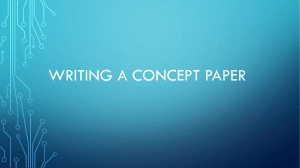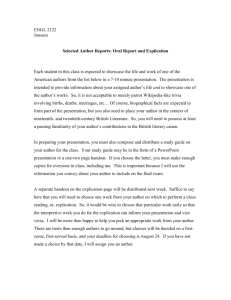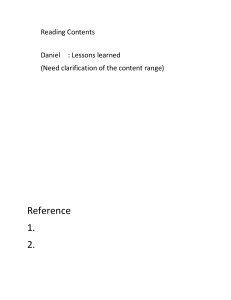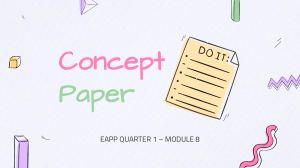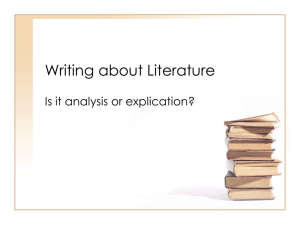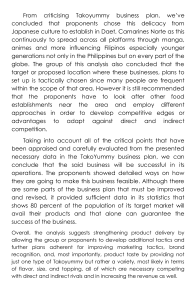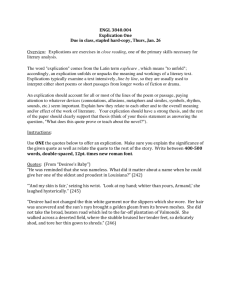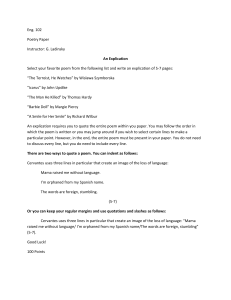Uploaded by
vivien samelo
Writing Concept Papers: Definition, Explication, Clarification
advertisement
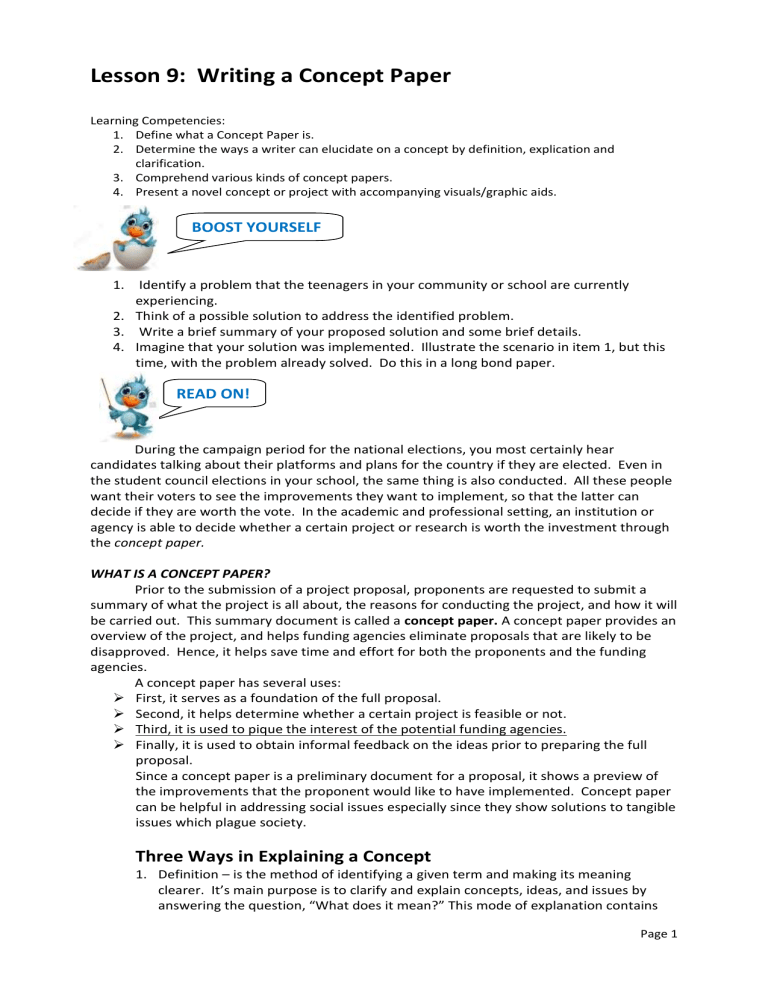
Lesson 9: Writing a Concept Paper Learning Competencies: 1. Define what a Concept Paper is. 2. Determine the ways a writer can elucidate on a concept by definition, explication and clarification. 3. Comprehend various kinds of concept papers. 4. Present a novel concept or project with accompanying visuals/graphic aids. BOOST YOURSELF 1. Identify a problem that the teenagers in your community or school are currently experiencing. 2. Think of a possible solution to address the identified problem. 3. Write a brief summary of your proposed solution and some brief details. 4. Imagine that your solution was implemented. Illustrate the scenario in item 1, but this time, with the problem already solved. Do this in a long bond paper. READ ON! During the campaign period for the national elections, you most certainly hear candidates talking about their platforms and plans for the country if they are elected. Even in the student council elections in your school, the same thing is also conducted. All these people want their voters to see the improvements they want to implement, so that the latter can decide if they are worth the vote. In the academic and professional setting, an institution or agency is able to decide whether a certain project or research is worth the investment through the concept paper. WHAT IS A CONCEPT PAPER? Prior to the submission of a project proposal, proponents are requested to submit a summary of what the project is all about, the reasons for conducting the project, and how it will be carried out. This summary document is called a concept paper. A concept paper provides an overview of the project, and helps funding agencies eliminate proposals that are likely to be disapproved. Hence, it helps save time and effort for both the proponents and the funding agencies. A concept paper has several uses: First, it serves as a foundation of the full proposal. Second, it helps determine whether a certain project is feasible or not. Third, it is used to pique the interest of the potential funding agencies. Finally, it is used to obtain informal feedback on the ideas prior to preparing the full proposal. Since a concept paper is a preliminary document for a proposal, it shows a preview of the improvements that the proponent would like to have implemented. Concept paper can be helpful in addressing social issues especially since they show solutions to tangible issues which plague society. Three Ways in Explaining a Concept 1. Definition – is the method of identifying a given term and making its meaning clearer. It’s main purpose is to clarify and explain concepts, ideas, and issues by answering the question, “What does it mean?” This mode of explanation contains Page 1 the term to be defined and the detailed exposition of the term through the use of illustrations, examples, and description. A definition can be presented in three ways: informal, formal, or extended. i. An informal definition : - Is done through a parenthetical or brief explanation. Example: Tocopherol (Vitamin E) is naturally found in vegetable oil, fish and nuts. - The writer uses known words or examples to explain an unknown term. These definitions may be synonyms or antonyms introduced by or, in other words, or like. Example: Freedom, also referred to as liberty or independence, is a state people reach when they are free to think and do whatever they please. ii. A formal definition explains a term by incorporating the term defined (species), the general category of the term (genus) and the quality that makes the term different from other terms in the same category (differentia). Example: Vitamin E is a light yellow fat-soluble vitamin that acts as an antioxidant. iii. An extended definition is a detailed way of defining a term and is usually composed of at least one paragraph. This type of definition incorporates various patterns of development (e.g. formal and informal definition, comparison and contrast, narration, description, classification, functional analysis, process, analogy, and cause and effect) to explain a given concept. Example: Subsequent to material design is the preparation of learning materials. Learning materials refer to both printed and non-printed objects or items that teachers and learners use to facilitate language learning. Nowadays, materials are becoming more and more sophisticated, incorporating authentic language samples and realias that help make a connection between classroom and real-life activities. They also incorporate information and communication technology (ICT), role plays, informationgap activities, songs, taped transcripts, integrated macroskills, and explicit rubrics. To better present ideas, you should identify the important elements contained in a definition. These include the term being defined, the detailed explanation, and the specific examples. The following signal words will also help you in writing this kind of text. Signal Words for Definition As defined for instance means to define For example is defined as such as to illustrate 2. Explication An explication is a method of explanation in which sentences, verses, quotes, or passages are taken from a literary or academic work and then interpreted and explained in a detailed way. When using this technique, you need to clearly present your thesis in the introduction and follow it up with a detailed analysis of a passage or text. You may begin the body of the explication by analyzing and explaining how the text was constructed. Your explication should end with a concise conclusion by restating your thesis and major arguments. Explication of “ The Road Not Taken.” The poem titled “ The Road Not Taken” by Robert Frost is about a man reflecting on a choice he once made. While the outcome of this choice is not implied to be Page 2 positive or negative the speaker notes that the choice in itself and the consequences of that choice have made a huge difference in the way his life has unfolded. The poem is about the importance of choices. The poem begins with the speaker regretting that he could not have been two people so he could have at some point in his life taken two roads instead of being confined to one. He looked as far as he could to see what was ahead on one of the roads he could have taken, but he was limited to seeing only as where it turned and disappeared in the bushes. In the second stanza, h e took the other road because it was grassy and was possibly better because it was less travelled, though not much more than the other road. The third stanza says both roads were covered in leaves that had been walked on infrequently, to the extent that the leaves covering them had not been made black from tramping feet. He also says he continued on the road he chose, and because he knew that the one thing leads to another (“way leafs on to way”) he doubted he Would ever return to this part of the road. Finally, he says he will tell the story when he is older (“Somewhere ages and ages hence”) that he had the choice of taking one An Excerpt from: http:efford.weebly.com/uploads/1/3/3/13833564/poetryexplicationexample.doc 3. Clarification Clarification is method of explanation in which the points are organized from a general abstract to specific to concrete examples. It entails the analysis of the concept by looking at the examples and specifying some of the characteristics to arrive at one working definition which can be used throughout the paper. The following signal words will help in writing this kind of text. Signal Words for Clarification after all as an example consider the following for example for instance in other words in particular in short namely put another way specifically stated differently that is to be specific to clarify to illustrate Sample Clarification Text Justice is a broad concept which encompasses a wide set of ideas, most of which also branch out into smaller notions. For instance, it can refer to the sentencing of a criminal based on due process. When an individual gets what he deserves, even outside the hands of the law, it is also considered justice in some context. This may come in the form of vigilante justice in which a person dissatisfied with the system doles out punishment to wrong-doers. Poetic justice is also another related concept which is used in literature to show how the good is always rewarded while bad forces always meet a grim end. In the context of this paper, justice will be clearly delineated into any instance in which the law is successfully and fairly applied to an individual, resulting in either an arrest or a release. To illustrate, if a thief is caught and tried in court through due process, and is found guilty and then sentenced accordingly, it can be said that justice was served. However, if the same thief is caught in the act by a band of villagers and was beaten right then and there, it will be considered justice in the context of the paper, as the process has not undergone due process. Parts of a Concept Paper A concept paper usually ranges from 500 to 2000 words and is usually divided into several parts. Page 3 The parts of a concept paper may also vary depending on the nature of the project/activity. The following are the two outlines of a concept paper based on the context. A. Concept Paper for a Project 1. Cover Page State the name of the proponents and their affiliations. State the addresses, contact numbers, and email addresses of the proponents. State the head of the agency and his/her contact information. State the date of submission. 2. Introduction State the information about the funding agency to show that you understand its mission. State the mission of the agency that the proponents represent and align it to the funding agency’s mission. Also, stat the year the proponents’ agency was established , its major accomplishments, and other detail that demonstrate its capability to undertake the proposed project. Present and describe other partner agencies and why they are qualified as such. Provide reasons why the funding agency should support the project. 3. Rationale or Background State the gap in knowledge to be addressed by the project. State the problem to be solved. State the project’s significance. 4. Project Description State the goals and objectives of the project. Present the methodology (sometimes termed as Action Plan, Project Activities, or Approach). Present the timeline expressed in months and year. Tate the benefits or anticipated outcomes. State how success of outcomes will be evaluated. 5. Project Needs and Cost Outline the main budget; include the item description and amount. Explain or justify how the budget will be used. List the personnel or equipment needed for the project. B. Concept Paper for Academic Research Use the following structure when you intend to present an idea or concept for a research you would like to pursue. 1. Title Page State your research title. State your name and school. State the date of submission. 2. Background of the Study Provide the current state of the field you are researching on. State the gap in knowledge and problems to be addressed by the research. Provide statistics and previous studies to prove your claims. State the reasons why you want to investigate on the chosen topic. State the theoretical and practical implications of your propsed research. Page 4 3. Preliminary Literature Review Provide a theoretical framework. The theoretical framework includes the theory that will guide you in the conduct of your research. Provide related literature that supports your topic. Provide related studies that will help you in conducting the research or analyzing and discussing the data. Provide a brief synthesis of the reviewed literature and studies. 4. Statement of the Problem/Objectives State your general problem in one sentence State your specific research questions or objectives. 5. Abridged Methodology Provide the context and participants of the study. Provide the instruments to be used. Provide the data collection procedure. Provide the data analysis scheme to be used. 6. Timeline Provide a timeline set in months and year. 7. References Provide a list of all books, journals, and other resources cited in your paper. TEST YOURSELF Activity 1 Write E if the statement shows an effective way of writing a concept paper and N if it is not. 1. Rino fails to indicate the page number in his concept paper. 2. Andrew included a literature review for the concept paper he made for his term paper. 3. Geryl includes in the references all journals he used but excludes the books he cited. 4. Thea made her timeline independent from the details in the methodology. 5. Yana requested a budget from the funding agency on the preparation of the concept paper. 6. Share states her objectives in the methodology section. 7. Maxine sticks to one format every time she submits concept paper to various funding agencies. 8. Ellie uses data from government agencies to prove the existence of a problem that she and her team would like to address. 9. Irish clarified the working definition of the concept she is preparing to ensure that the reader understood it properly. 10. When Theresa knew that her target readers are lay persons, she defined the technical terms that she used in the concept paper. Activity 2 Modified True or False. Write T if the statement is true, and if it is false, underline the word or group of words that make the statement false, then write the correct answer of the space provided before each number. Page 5 __________1. One way of explaining a concept is by an extended explanation which identifies a given term and making its meaning clear. __________2. In writing a concept paper, it is necessary to clarify the objectives of our research or project. __________3. A concept is necessary in making a project proposal because it helps funding agencies eliminates proposals that are likely to be disapproved. __________4. A formal definition is a detailed way of defining a term and is usually composed of at least one paragraph. __________5. An explication is a method of explanation in which the points are organized from a general abstract idea to specific and concrete examples. __________6. The parts of a concept paper may vary depending on the nature of the project/activity. __________7. The title page for Academic Research states the name of the proponents and their affiliations. __________8. In stating the Statement Problem for Academic Research you have to state your problem in a long paragraph. __________9. The Preliminary Literature Review, provides the data collection procedure of the study. __________10. The Rationale or Background state the gap in knowledge to be addressed by the project. __________11. It is not necessary to cite your references in writing a Concept Paper. __________12. We write our objectives in the Methodology section of our Concept Paper. __________13. The head of the agency and his/her contact information stated in the Cover Page of a Concept Paper. __________14. It is necessary to write the date of submission in the Title Page of a Concept Paper. __________15. The reasons why the funding agency should support the project are stated in the Rationale or Background of a project proposal. Activity C Answer the following questions correctly: 1. What are the kinds of Concept Paper 2. How does each concept paper begin? 3. Are the structures of each concept paper the same? Write down the structures of each concept paper in their proper order. Note: For Activity C, write your answers on a separate sheet of paper. MY TAKE AWAY Based on what you have learned about the concept paper, make a creative and informative article about the top 5 reasons why and how concept paper can contribute to societal change. Type this on a separate short bond paper. SELF-AUDIT Think of a problem in your family or community. Using a minimum of 300 words and a maximum of 700 words, WRITE a Concept Paper to present your solution to this problem. Page 6 Follow the structure used in writing a Concept Paper for a Project or Academic Research. The budget section is optional. Follow the format below when writing your paper. Short bond paper Times New Roman, 12 1.5 spacing 1” margin on all sides Page 7 Page 8
